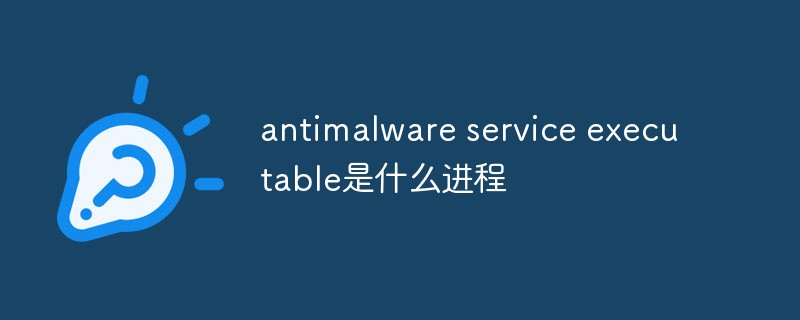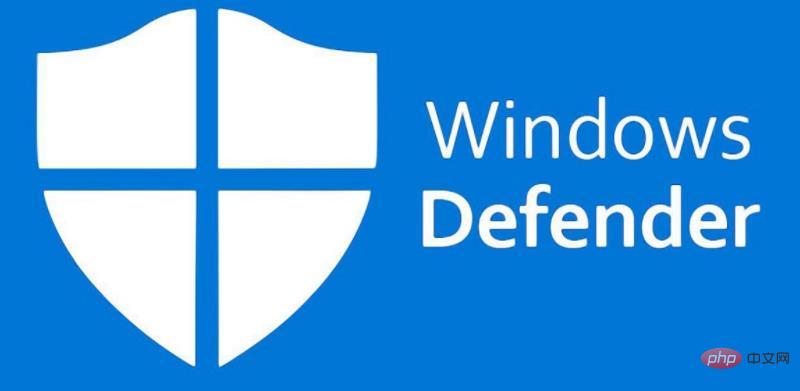What process is antimalware service executable?
antimalware service executable is a system process related to Microsoft anti-virus software Windows Defender and is a normal system process. The specific name of the process is "MsMpEng.exe", the general size is "15.6KB", and the location is "C:\ Program Files\Windows Defender".

#The operating environment of this tutorial: Windows 10 system, Dell G3 computer.
What is the process of antimalware service executable?
Antimalware Service Executable process is a related system process of Microsoft anti-virus software Windows Defender. It is a normal system process. The specific name of the process is MsMpEng.exe. The general size is 15.6KB and the location is C:\ Program Files\Windows Defender. The reason why it takes up a lot of system resources when starting up is generally because it automatically scans the hard disk and files. It is used to remove, isolate and prevent spyware, etc.

Can the Antimalware Service Executable process be ended?
Under normal circumstances, we cannot end related system services, but we can set Windows Defender to exclude non-system disks and related files when scanning (too cumbersome and of no practical value), or end its impact on the system. Protect. The specific operation method is:
1. Exclude scanning non-system disks
Open Windows Defender, click the "Settings" option, click on the left panel to switch to the "Excluded files and locations" option. Use "Browse" and "Add" to exclude non-system disks from automatic scanning
2. Disable Windows Defender
Open Windows Defender, in the settings interface, click " Administrator" and uncheck "Enable this app".
Related expansion:
Windows Defender, now named Microsoft Defender, formerly known as Microsoft Anti Spyware, is an anti-virus program that can run on Windows XP and Windows Server 2003 operating systems, and has been Built into Windows Vista, Windows 7, Windows 8, Windows 8.1, Windows 10 and Windows 11. Its beta version was released on January 6, 2005, and Microsoft released updated beta versions on June 23, 2005, and February 17, 2006. Windows Defender's definition library is updated frequently. Unlike other similar free products that can only scan the system, Windows Defender can also monitor the system in real time. Starting from Windows 10, Windows Defender has added right-click scanning and offline antivirus. According to the latest daily sample test, the killing rate has been greatly improved and has reached the international first-class level.
In March 2019, Microsoft changed the name of Windows Defender Advanced Threat Protection to Microsoft Defender ATP, and then Microsoft introduced ATP to Mac.
In April 2020, in the Windows 10 May 2020 Update (2004), Microsoft updated the Windows Security Center app to change Windows Defender to Microsoft Defender.
For more related knowledge, please visit the FAQ column!
The above is the detailed content of What process is antimalware service executable?. For more information, please follow other related articles on the PHP Chinese website!

Hot AI Tools

Undress AI Tool
Undress images for free

Undresser.AI Undress
AI-powered app for creating realistic nude photos

AI Clothes Remover
Online AI tool for removing clothes from photos.

Clothoff.io
AI clothes remover

Video Face Swap
Swap faces in any video effortlessly with our completely free AI face swap tool!

Hot Article

Hot Tools

Notepad++7.3.1
Easy-to-use and free code editor

SublimeText3 Chinese version
Chinese version, very easy to use

Zend Studio 13.0.1
Powerful PHP integrated development environment

Dreamweaver CS6
Visual web development tools

SublimeText3 Mac version
God-level code editing software (SublimeText3)
 How to fix VIDEO_TDR_FAILURE (nvlddmkm.sys)
Jul 16, 2025 am 12:08 AM
How to fix VIDEO_TDR_FAILURE (nvlddmkm.sys)
Jul 16, 2025 am 12:08 AM
When encountering the blue screen error VIDEO_TDR_FAILURE(nvlddmkm.sys), priority should be given to troubleshooting graphics card driver or hardware problems. 1. Update or rollback the graphics card driver: automatically search and update through the device manager, manually install or roll back to the old stable driver using NVIDIA official website tools; 2. Adjust the TDR mechanism: Modify the TdrDelay value in the registry to extend the system waiting time; 3. Check the graphics card hardware status: monitor the temperature, power supply, interface connection and memory module; 4. Check system interference factors: run sfc/scannow to repair system files, uninstall conflicting software, and try safe mode startup to confirm the root cause of the problem. In most cases, the driver problem is first handled. If it occurs repeatedly, it needs to be further deepened.
 How to change your name on Facebook?
Jul 13, 2025 am 12:03 AM
How to change your name on Facebook?
Jul 13, 2025 am 12:03 AM
The Facebook name change process is simple, but you need to pay attention to the rules. First, log in to the application or web version and go to "Settings and Privacy" > "Settings" > "Personal Information" > "Name", enter a new name, and save it; secondly, you must use your real name, it cannot be modified frequently within 60 days, it cannot contain special characters or numbers, and it cannot be impersonated by others, and the review does not pass the auxiliary verification such as uploading ID cards; it usually takes effect within a few minutes to 3 working days after submission; finally, the name change will not notify friends, the homepage name will be updated simultaneously, and the old name will still be displayed in the history record.
 Why do I get a User Account Control (UAC) prompt every time
Jul 13, 2025 am 12:12 AM
Why do I get a User Account Control (UAC) prompt every time
Jul 13, 2025 am 12:12 AM
UAC frequently pops up because the running program requires administrator permissions or the system setting level is too high. Common reasons include installation of software, modifying system settings, running third-party tools and other operation triggers. If using an administrator account, UAC only confirms the operation and not blocks. The methods for reducing prompts include: canceling the program to run as an administrator, lowering the UAC notification level, using a standard user account, and starting the program through the task planner. It is not recommended to turn off UAC completely because it can effectively prevent malicious programs from tampering with the system. You can set the UAC to "notify only when the program changes the computer" to balance security and experience.
 How to fix 'The cloud file provider is not running'
Jul 14, 2025 am 12:24 AM
How to fix 'The cloud file provider is not running'
Jul 14, 2025 am 12:24 AM
When the "Thecloudfileproviderisnotrunning" error appears, the cloud file service should be restarted first. The method is to open the service manager (services.msc), find CloudFileProvider or related services (such as OneDrive), and right-click to select Restart; if the service is not listed, you may need to reinstall or repair the cloud storage application, such as uninstalling and reinstalling through the settings menu; at the same time, make sure that the system and application are both the latest versions, go to Windows Update and in-app to check for updates; you also need to confirm that the cloud service is allowed to run in the background, enter the privacy settings to enable the background permissions of the corresponding application; finally, if the problem is still not solved, you can try to clear the cloud file cache.
 How to fix 'The update is not applicable to your computer'
Jul 12, 2025 am 12:12 AM
How to fix 'The update is not applicable to your computer'
Jul 12, 2025 am 12:12 AM
When you encounter a prompt that "update is not applicable to your computer", most of it is caused by mismatch in the system or hardware. Solutions include: 1. Make sure that the system version is consistent with the update package, and prioritize the use of Microsoft official updates; 2. Check whether the system type (32-bit/64-bit) matches; 3. Run sfc/scannow to repair the system files; 4. Check whether the hardware meets the update requirements, such as memory, disk space and TPM modules, etc.; 5. Enter the BIOS to check the relevant settings if necessary.
 Can I run a 32-bit plugin in a 64-bit program
Jul 12, 2025 am 12:43 AM
Can I run a 32-bit plugin in a 64-bit program
Jul 12, 2025 am 12:43 AM
Yes,youcanoftenruna32-bitpluginina64-bitprogram.1.UseabridgingtoolincludedinmanyDAWslikeFLStudio,Cubase,andReaper.2.Runa32-bitversionoftheDAWfornativesupport.3.Usethird-partyhostssuchasJBridgeorSaviHost.However,issueslikelatencyspikes,crashes,licensi
 What is the difference between a portable app and an installed app
Jul 12, 2025 am 12:26 AM
What is the difference between a portable app and an installed app
Jul 12, 2025 am 12:26 AM
Choosing a portable application or installing an application mainly depends on the usage scenario. 1. Installing the application will integrate the system in depth, distributed in multiple directories, and may modify settings and add background services. Uninstalling requires system uninstallation tools; 2. Portable applications do not need to be installed, all files are concentrated in one folder, and the system settings are not changed during runtime. Delete only requires directly removing folders; 3. Installing the application is suitable for scenarios where automatic updates, deep system integration and offline functions are required; 4. Portable applications are suitable for users who use multiple devices, system diagnosis or prefer lightweight tools. Both have their own advantages and disadvantages and should be chosen according to specific needs.
 How to fix 'This PC is not currently set up to install or run programs from the Microsoft Store'?
Jul 12, 2025 am 12:43 AM
How to fix 'This PC is not currently set up to install or run programs from the Microsoft Store'?
Jul 12, 2025 am 12:43 AM
If you encounter the "ThisPCisnotcurrently setuptoinstallorrunprogramsfromtheMicrosoftStore" error, it is usually because the system settings restrict the application installation. Solutions include: 1. Check whether SMode is enabled. If enabled, go to Microsoft's official website for free to log out; 2. Enable the Microsoft Store platform function, enable Windows MediaPlayer and Microsoft Store platforms through "Optional Functions" and restart; 3. Professional or Enterprise version users can disable the policy restricting Store access through the local Group Policy Editor and restart; 4. All users can try it.






